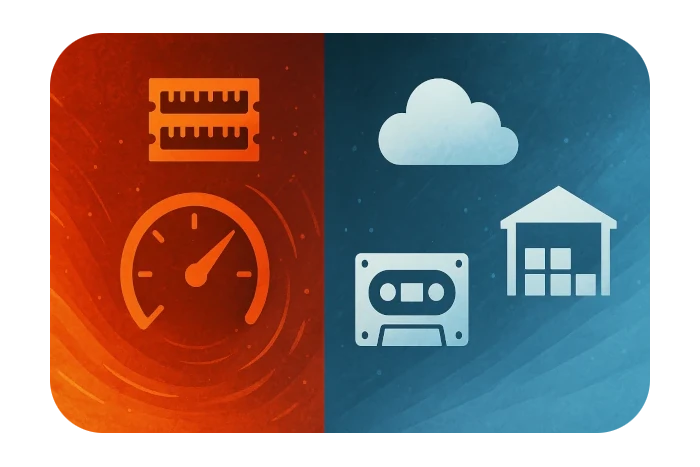
Hot vs Cold Data Tiers: Concepts, Tech Choices & Use-Cases
Written by Javier Esteban · 12 July 2025
In this article we demystify the hot- and cold-data tiers: we start by defining each tier and the performance trade-offs they entail, map the most common technologies to their ideal tier, showcase real-world use-cases, and wrap up with a side-by-side comparison that helps you choose the right storage strategy for every workload.
Hot Tier
The hot tier holds the data your system must read or mutate right now. Low latency (sub-second) and high throughput trump everything else, even if that means higher cost or shorter retention. Common techniques:
- Keep writes in RAM and flush to disk asynchronously.
- Apply a TTL so only the freshest records stay resident.
- Scale horizontally – distribute keys / shards across many nodes instead of inflating a single box.
| Technology | Type | Latency | Durability | Aggregation | Scale | Sweet Spots |
|---|---|---|---|---|---|---|
| Redis / Redis Cluster | Cache / KV store | 🔥🔥🔥 | Optional | Basic | Cluster-wide | Sessions, tokens, rate-limits |
| Amazon ElastiCache | Managed Redis/Memcached | 🔥🔥🔥 | Optional | Basic | Auto-sharding | Stateless micro-services, serverless back-ends |
| Apache Druid | Realtime OLAP DB | 🔥🔥 | Yes | Advanced | Horizontal | Click-stream dashboards |
| Apache Pinot | Realtime OLAP DB | 🔥🔥🔥 | Yes | Advanced++ | Horizontal | Sub-second BI queries on billions of rows |
| Kafka + ksqlDB | Event-stream SQL | 🔥🔥 | Yes (log) | Medium | Horizontal | Real-time enrichment / anomaly detection |
| Apache Flink | Stateful stream engine | 🔥🔥 | Partial | Rich | Horizontal | Complex CEP, sliding windows |
| ClickHouse | Columnar OLAP DB | 🔥🔥 | Yes | Strong | Manual cluster | Technical telemetry, large-scale log analytics |
| Amazon Timestream | Managed TSDB | 🔥🔥 | Yes | Medium | On-demand | IoT, sensor fleets |
| DynamoDB + DAX | NoSQL + in-memory cache | 🔥🔥🔥 | Yes | Basic | Auto-scaling | High-velocity catalog / user-profile look-ups |
| Google Bigtable | Wide-column NoSQL | 🔥🔥 | Yes | Limited | Global | Live telemetry, alerting pipelines |
| Azure Cosmos DB | Multi-model NoSQL | 🔥🔥 | Yes | Medium | Global | Low-touch serverless apps |
Typical hot-tier use-cases:
| Domain | Example |
|---|---|
| IoT / Smart-City | Millisecond sensor readings |
| Video streaming | Per-viewer QoE metrics |
| FinTech | Fraud scoring during payment authorisation |
| AdTech | RTB bidding and audience targeting |
| Telco | Cell-tower KPIs, predictive maintenance |
| Gaming | Matchmaking, player state, live events |
| Infrastructure monitoring | Prometheus-style metrics, instant alerting |
| Connected vehicles | Fleet tracking, OTA diagnostics |
| Interactive BI dashboards | “Live mode” KPI boards in Superset or Tableau |
Cold Tier
The cold tier stores everything that no longer needs millisecond access but must be retained for months or years. Optimise for cost-per-TB and batch analytics, not latency.
Characteristics:
- Petabyte-scale, cheap object or archival storage
- Seconds-to-minutes query times are acceptable
- Batch ETL, ML model training, compliance audit
| Technology / Service | Type | Primary Role |
|---|---|---|
| S3 / GCS / ADLS | Object storage | Data lake in Parquet/ORC |
| Hadoop HDFS | Distributed FS | Spark / Hive batch processing |
| S3 Glacier / Azure Archive | Deep archive | Back-ups, legal hold, DR |
| Delta Lake | Lakehouse layer | ACID tables, versioned data |
| Apache Iceberg | Lakehouse layer | Time-travel, schema evolution |
| Apache Hudi | Lakehouse layer | Incremental upserts, ACID |
| BigQuery / Athena / Redshift Spectrum | SQL on object store | Ad-hoc analytics on Parquet |
| Hive / Presto / Trino | Distributed query engine | OLAP on HDFS or data lake |
| Spark (batch) | Compute engine | ETL, ML, heavy aggregation |
Good practices:
- Store files column-oriented & compressed (Parquet, ORC).
- Decouple compute – access S3 data with Trino, Spark, BigQuery.
- Version datasets with Iceberg / Delta for reproducibility.
- Partition by date / domain to prune scans.
- Auto-tier aged data out of the hot layer via TTL or scheduled jobs.
Side-by-side Summary
| Criterion | Hot Tier | Cold Tier |
|---|---|---|
| Latency | Milliseconds → seconds | Seconds → minutes |
| Access frequency | High | Low |
| Cost per GB | High | Low |
| Retention | Hours → days | Months → years |
| Typical tech | Redis, Pinot, Kafka | S3, Iceberg, Spark, BigQuery |
| Primary use | Real-time monitoring & response | Historical analytics & audit |
Need help sizing your hot cache or designing an Iceberg-based lake-house? Ping the Crow Tech team – we love chatting data architecture.
Not quite ready for a consultation?
Drop us a message, and we'll respond with the information you're looking for.